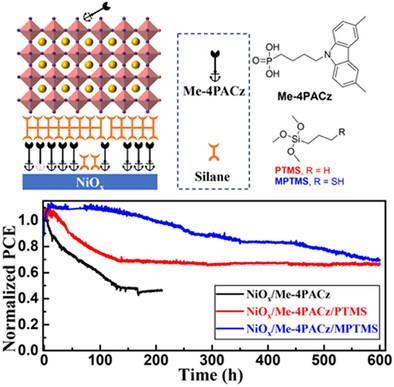稳定倒钙钛矿太阳能电池抗溶剂性提高的自组装双层膜
IF 12.1
2区 材料科学
Q1 CHEMISTRY, MULTIDISCIPLINARY
引用次数: 0
摘要
在钙钛矿薄膜加工和器件运行过程中,ITO或金属氧化物传输层上的自组装单层(SAM)分子容易解吸,导致功率转换效率(PCE)降低和器件退化。因此,开发有效的策略来稳定界面处的sam对于进一步提高基于sam的钙钛矿太阳能电池(PVSCs)的性能和稳定性至关重要。本文开发了一种简便的方法,通过将交联有机硅烷,正丙基三甲氧基硅烷(PTMS)和(3-巯基丙基)三甲氧基硅烷(MPTMS)沉积在广泛使用的Me-4PACz SAM上进行NiOx改性,构建坚固的自组装双层膜(SABs)。Me-4PACz具有优异的孔洞提取能力,抑制了界面反应和重组,而交联的有机硅烷网络形成了一个强大的保护层,可以防止溶剂诱导的SAM脱附并填充分子空隙,从而产生更紧凑和稳定的界面。此外,MPTMS中的巯基可以与钙钛矿埋藏界面处的欠配位Pb2+发生强烈的相互作用,进一步减轻了界面缺陷。因此,基于NiOx/Me-4PACz/MPTMS的PVSCs在空气中连续1个太阳等效光照下实现了24.9%的高PCE和475小时的T80寿命,而基于NiOx/Me-4PACz的控制装置为23.3%和数十小时。这项工作为设计高性能和高度稳定的PVSCs提供了重要的见解。本文章由计算机程序翻译,如有差异,请以英文原文为准。

Self-Assembled Bilayers with Improved Solvent Resistance for Stable Inverted Perovskite Solar Cells
The self-assembled monolayer (SAM) molecules on ITO or metal oxide transporting layers tend to desorb during perovskite film processing and device operation, leading to reduced power conversion efficiency (PCE) and device degradation. Developing effective strategies to stabilize SAMs at interfaces is therefore crucial for further improving the performance and stability of SAM-based perovskite solar cells (PVSCs). Here, a facile method is developed to construct robust self-assembled bilayers (SABs) by depositing cross-linkable organosilanes, n-propyltrimethoxysilane (PTMS) and (3-mercaptopropyl)trimethoxysilane (MPTMS), onto the widely used Me-4PACz SAM for NiOx modification. Me-4PACz enables excellent hole extraction, suppresses interfacial reactions and recombination, while the cross-linked organosilane network forms a robust protective layer that prevents the solvent-induced SAM desorption and fills molecular voids, yielding a more compact and stable interface. In addition, the thiol group in MPTMS can strongly interact with the undercoordinated Pb2+ at the buried interface of perovskite, further mitigating interfacial defects. Consequently, NiOx/Me-4PACz/MPTMS based PVSCs achieve a high PCE of 24.9% with a T80 lifetime of 475 h under continuous 1 sun equivalent illumination in air, compared to 23.3% and tens of hours for NiOx/Me-4PACz-based control device. This work provides important insights into designing robust interfaces for high-performance and highly stable PVSCs.
求助全文
通过发布文献求助,成功后即可免费获取论文全文。
去求助
来源期刊

Small
工程技术-材料科学:综合
CiteScore
17.70
自引率
3.80%
发文量
1830
审稿时长
2.1 months
期刊介绍:
Small serves as an exceptional platform for both experimental and theoretical studies in fundamental and applied interdisciplinary research at the nano- and microscale. The journal offers a compelling mix of peer-reviewed Research Articles, Reviews, Perspectives, and Comments.
With a remarkable 2022 Journal Impact Factor of 13.3 (Journal Citation Reports from Clarivate Analytics, 2023), Small remains among the top multidisciplinary journals, covering a wide range of topics at the interface of materials science, chemistry, physics, engineering, medicine, and biology.
Small's readership includes biochemists, biologists, biomedical scientists, chemists, engineers, information technologists, materials scientists, physicists, and theoreticians alike.
 求助内容:
求助内容: 应助结果提醒方式:
应助结果提醒方式:


